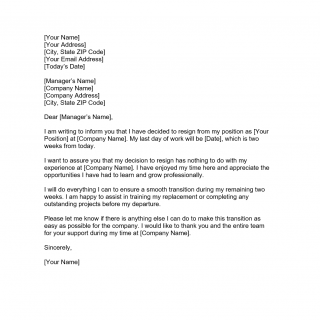Resignation Letter with 2 Weeks Notice
A resignation letter with 2 weeks notice is a formal document used by employees to inform their employer that they intend to resign from their position. The main purpose of this letter is to provide notice to the employer, as well as to ensure a smooth transition for both parties.
The letter should start with a clear statement of the employee's intention to resign, followed by the effective date of the resignation, which should be at least 2 weeks from the date of the letter. It is important to express gratitude for the opportunities and experiences gained while working for the employer, and to offer assistance in transitioning responsibilities to a new employee.
The parties involved in the letter are the employee and the employer. It is important to consider the legal and professional implications of the resignation, as well as any potential consequences for the employee, such as forfeiting benefits or severance pay. The letter should be signed by the employee and a copy should be kept for future reference.
Important fields to include in the letter are the employee's name, job title, department, and contact information, as well as the date of the letter and the effective date of the resignation. It is also important to indicate the reason for resignation, although this is not strictly necessary.
When compiling the letter, the employee will need to consider any contractual obligations or company policies regarding resignation and notice periods. It may also be helpful to consult with HR or legal counsel to ensure that the letter is legally sound and aligned with company policies.
Application examples and use cases for the letter include resigning from a job due to a better opportunity, personal reasons, or dissatisfaction with the current job. The letter can also be used to resign from a position that is no longer fulfilling or that does not align with the employee's career goals.
Resignation Letter with 2 Weeks Notice example
[Your Name]
[Your Address]
[City, State ZIP Code]
[Your Email Address]
[Today’s Date][Manager’s Name]
[Company Name]
[Company Address]
[City, State ZIP Code]Dear [Manager’s Name],
I am writing to inform you that I have decided to resign from my position as [Your Position] at [Company Name]. My last day of work will be [Date], which is two weeks from today.
I want to assure you that my decision to resign has nothing to do with my experience at [Company Name]. I have enjoyed my time here and appreciate the opportunities I have had to learn and grow professionally.
I will do everything I can to ensure a smooth transition during my remaining two weeks. I am happy to assist in training my replacement or completing any outstanding projects before my departure.
Please let me know if there is anything else I can do to make this transition as easy as possible for the company. I would like to thank you and the entire team for your support during my time at [Company Name].
Sincerely,
[Your Name]
Strengths of the letter include its ability to provide a clear and professional notice of resignation, as well as to ensure a smooth transition for both parties. Weaknesses include the potential for the letter to damage the employer-employee relationship, and the risk of losing benefits or severance pay. Opportunities include the potential for the letter to open new doors and opportunities for the employee, while threats include the potential for difficulty finding a new job or adjusting to a new work environment.
Related forms may include exit interviews, employment contracts, or severance agreements. The main difference between these forms and the resignation letter is the context and purpose.
Overall, the resignation letter with 2 weeks notice is an important tool for employees to inform their employer of their intention to resign and ensure a smooth transition for both parties. By providing clear notice and expressing gratitude, employees can maintain a positive relationship with their employer and pave the way for future opportunities. The letter should be submitted to the employer in person or via email, and a copy should be kept for future reference.

